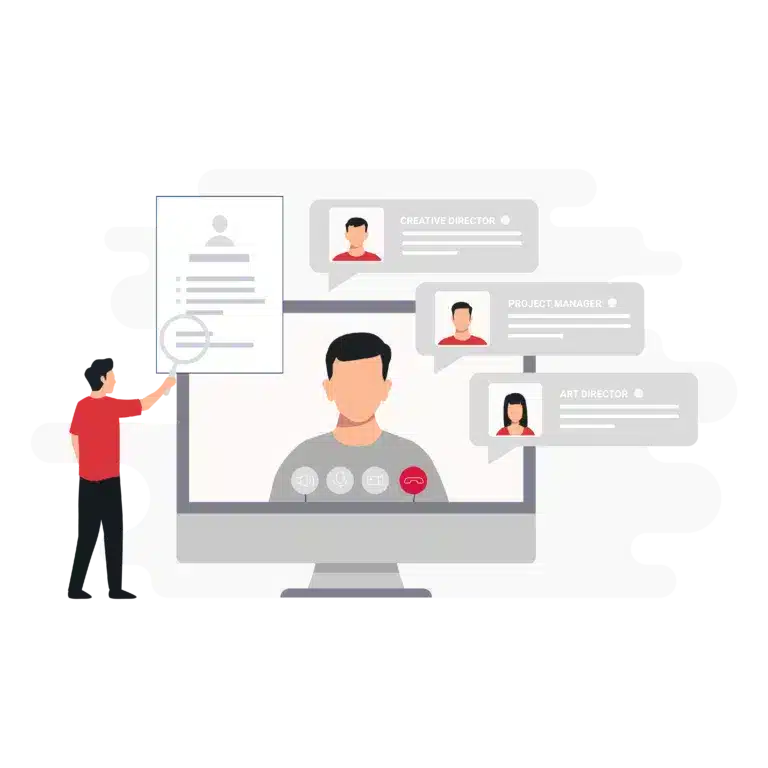In today’s fast-paced and highly competitive job market, staying ahead of the recruitment game is paramount. Recruiters, founders, and hiring managers are constantly seeking ways to streamline processes, improve candidate experiences, and make data-driven decisions. As the recruitment landscape evolves, technology emerges as a critical ally in achieving these goals. In this blog, we’re diving into the world of recruitment technology, highlighting five key innovations that are reshaping the future of recruitment.
According to thrive my way, the most popular applicant tracking software is as follows: BambooHR, SmartRecruiters, Workday, Submittable, and Greenhouse.
In an era where attracting, assessing, and retaining top talent is more challenging than ever, recruitment technology has become a game-changer. It not only enhances the efficiency of the hiring process but also ensures that the right candidate is matched with the right opportunity, improving the quality of hires.
Whether you’re a seasoned recruiter, a forward-thinking founder, or a hiring manager striving to make the best choices for your organization, understanding and implementing these cutting-edge technologies can make all the difference. Join us as we explore the role of AI-powered candidate matching, video interviewing platforms, applicant tracking systems, chatbots and virtual assistants, and diversity and inclusion software in shaping the future of recruitment. These technologies are not just buzzwords; they are essential tools for building the workforce of tomorrow. Let’s embark on this journey into the future of talent acquisition, where innovation and efficiency go hand in hand.
AI-Powered Candidate Matching as a recruitment technology
In the dynamic world of recruitment, identifying the right candidate from a sea of resumes has always been a challenge. But with the advent of AI-powered candidate matching technology, recruiters, founders, and hiring managers are experiencing a transformative shift in their ability to make precise, data-driven decisions. This technology utilizes advanced algorithms and machine learning to analyze vast amounts of data, allowing for more accurate and efficient candidate assessments.
At its core, AI-powered candidate matching simplifies the process of sifting through resumes and job descriptions. Traditionally, this task was labor-intensive and prone to human biases. However, AI can instantly compare a candidate’s qualifications, skills, and experience with the requirements of a job posting, providing recruiters with a shortlist of candidates who are the best fit for the role.
The benefits of this technology extend far beyond just saving time. It significantly enhances the quality of hires. Recruiters can be more confident that they are not missing out on the ideal candidate due to human oversights or limitations. By reducing the chances of human error, AI-powered candidate matching increases the likelihood of selecting candidates who are not only qualified but also aligned with the company’s culture and values.
This technology goes beyond keyword matching; it can understand context, identify relevant skills, and even recognize potential soft skills that might not be explicitly mentioned in a resume. In a rapidly evolving job market where the demand for specific skills fluctuates, AI ensures that recruiters stay up-to-date with the latest qualifications and certifications that are essential for a particular role.
AI-powered candidate matching doesn’t replace the human touch in recruitment but complements it. Recruiters can use the insights provided by AI to make more informed decisions, conduct more tailored interviews, and engage with candidates on a deeper level. This fusion of human expertise and artificial intelligence is proving to be a powerful combination that is reshaping the recruitment landscape.
The future of recruitment hinges on the ability to harness AI to make the process more efficient and effective. Incorporating AI-powered candidate matching into your recruitment strategy is a strategic move, providing a competitive edge in identifying the best talent swiftly and accurately. As we delve deeper into the other recruitment technologies on our list, you’ll see how they further refine the recruitment process, creating a more efficient and candidate-centric experience for all stakeholders.
Video Interviewing Platforms as a recruitment technology
Recruitment has always been about connecting with the right people, assessing their qualifications, and determining their fit for a particular role. Traditionally, this meant in-person interviews, phone screenings, and an often tedious, time-consuming process. However, the emergence of video interviewing platforms has ushered in a new era of efficiency and convenience for recruiters, founders, and hiring managers.
Video interviewing platforms offer several significant advantages in the talent acquisition process. Perhaps the most notable benefit is the ability to conduct interviews remotely, which is especially valuable in our increasingly globalized job market. Whether a candidate resides in another city or another continent, video interviews bridge the geographical gap, making it possible to evaluate talent without the need for face-to-face meetings.
One of the key features that has contributed to the popularity of video interviews is the ability to record and review them. This allows multiple team members to assess candidates at their own convenience, which is particularly helpful in collaborative hiring environments. It also reduces the risk of bias during initial screenings, as assessments are based solely on qualifications and responses rather than personal impressions.
Furthermore, video interviewing platforms often come with automated scheduling tools, simplifying the logistical aspect of recruitment. Recruiters and hiring managers can coordinate interviews seamlessly, ensuring that candidates are engaged without unnecessary delays. This streamlines the candidate experience, showing that your organization values their time and effort.
The future of recruitment is undoubtedly intertwined with the continued evolution of video interviewing technology. It not only accelerates the hiring process but also enhances the overall quality of interviews. As you explore the other recruitment technologies on our list, you’ll see how they, too, are designed to make the entire talent acquisition journey smoother, more efficient, and more candidate-friendly. Video interviewing platforms are a testament to the industry’s commitment to embracing innovation and adapting to the changing needs of both recruiters and candidates.
Applicant tracking systems (ATS) as a recruitment technology
Applicant Tracking Systems, commonly known as ATS, have been the backbone of the recruitment industry for quite some time. But, in the ever-evolving landscape of talent acquisition, these systems have not remained static. They have continually evolved to cater to the increasingly complex needs of recruiters, founders, and hiring managers.
Modern ATS solutions are all-encompassing, serving as a central hub for managing the entire recruitment process. They are designed to streamline and simplify every aspect of talent acquisition, from posting job openings to onboarding new hires. These systems bring a level of automation and organization that not only saves time but also ensures a seamless and efficient hiring process.
One of the standout features of contemporary ATS is its integration capabilities. These systems are designed to seamlessly connect with other HR tools and platforms, enabling the exchange of data and information. This connectivity creates a holistic view of the recruitment process, allowing for better-informed decisions and streamlined workflows. Recruiters can access candidate information, communication history, and hiring status without switching between multiple applications, saving valuable time and reducing the chances of errors.
Moreover, mobile optimization is a key aspect of modern ATS. As more candidates engage with job opportunities through their mobile devices, ATS software has adapted to meet these preferences. Job postings, application submissions, and even interview scheduling can now be conveniently managed through mobile applications, ensuring that you can reach a broader pool of talent and offer an improved candidate experience.
Applicant Tracking Systems also play a pivotal role in data-driven recruitment. They provide detailed analytics and reporting tools that offer insights into the effectiveness of your hiring process. Recruiters and hiring managers can analyze data on key performance indicators, such as time-to-hire, source of hire, and candidate pipeline health. This data-driven approach not only allows for continuous improvement but also facilitates better decision-making.
In a rapidly changing job market, ATS continues to be a fundamental recruitment technology. As you delve deeper into the other technologies on our list, you’ll see how they complement and enhance the capabilities of ATS, ultimately reshaping recruitment into a more agile, data-informed, and user-friendly process. The future of talent acquisition is undoubtedly intertwined with the continuing innovation and integration of Applicant Tracking Systems.
Chatbots and virtual assistants as a recruitment technology
In an era characterized by rapid technological advancements and the need for efficient, responsive recruitment processes, chatbots and virtual assistants have emerged as powerful allies for recruiters, founders, and hiring managers. These AI-driven conversational agents are transforming the way candidates and organizations engage during the recruitment journey.
Chatbots and virtual assistants serve multiple crucial functions in the recruitment process. They are available 24/7 to respond to candidate inquiries, instantly offering information about job openings, company culture, application status, and other frequently asked questions. This round-the-clock availability enhances the candidate experience by providing timely and convenient support.
Additionally, these AI-powered assistants excel at initial candidate screening. They can ask predefined questions, evaluate responses, and assess a candidate’s suitability based on predetermined criteria. By automating this early-stage screening process, recruiters can focus their attention on the most promising candidates, saving time and resources.
Another significant benefit of chatbots and virtual assistants is their role in interview scheduling. They can coordinate interview times and locations, sending reminders to both candidates and interviewers. This feature reduces scheduling conflicts, eliminates the risk of missed appointments, and ensures a smooth interview process.
Furthermore, chatbots can gather feedback from candidates, helping organizations gauge the candidate experience and continuously improve their recruitment process. This feedback loop is invaluable in refining hiring strategies and maintaining a positive employer brand.
Chatbots and virtual assistants are not intended to replace human recruiters but to complement and enhance their efforts. While they excel at routine, repetitive tasks, human recruiters bring the vital human touch, empathy, and judgment necessary for more complex aspects of recruitment.
As we look to the future of recruitment, chatbots and virtual assistants are poised to play a more significant role in creating seamless and engaging experiences for candidates and streamlining the workflow for recruiters. They represent a dynamic shift towards responsive, efficient, and candidate-centric hiring processes, reflecting the evolving needs of both job seekers and organizations. In the sections that follow, we’ll explore other innovative recruitment technologies that are shaping the future of talent acquisition.
Diversity and inclusion software as a recruitment technology
In the evolving landscape of recruitment, diversity and inclusion (D&I) have become not just buzzwords but essential elements of a successful talent acquisition strategy. The integration of Diversity and Inclusion Software is an acknowledgment of the growing importance of diversity and its direct correlation to innovation, productivity, and success in organizations.
D&I software provides critical tools and insights for recruiters, founders, and hiring managers to foster diverse and inclusive workplaces. These platforms offer features such as analytics and reporting, helping organizations measure their diversity efforts and identify areas where improvement is needed. With data-driven insights, employers can make informed decisions regarding their recruitment and retention strategies, ultimately contributing to a more diverse workforce.
One key feature of D&I software is blind recruitment, which aims to reduce unconscious bias in the selection process. Resumes and applications can be anonymized, removing information that could reveal gender, ethnicity, or other identifying characteristics. This levels the playing field and ensures that candidates are evaluated based solely on their qualifications and skills.
These tools also offer insights into diverse candidate sourcing. Recruiters can access databases of underrepresented talent and connect with candidates who may not have traditionally been part of their recruitment network. This broadens the talent pool, increasing the chances of finding exceptional individuals who bring a fresh perspective to the organization.
Moreover, D&I software promotes inclusive language and job descriptions. These platforms can analyze job postings to identify and suggest changes in language that may deter diverse candidates. This not only attracts a wider range of applicants but also reflects an organization’s commitment to inclusivity.
As organizations increasingly recognize the significance of diversity and inclusion, the implementation of D&I software is an investment in not only a more equitable workforce but also a stronger employer brand. In the following sections of this blog, we’ll delve into other technologies that are shaping the future of recruitment, showing how they complement and reinforce the principles of diversity and inclusion in the talent acquisition process.
Conclusion
The recruitment landscape is evolving at an unprecedented pace, driven by the integration of cutting-edge technologies that are revolutionizing the way we identify, engage, and hire top talent. In this exploration of five key recruitment technologies shaping the future of talent acquisition, we’ve witnessed the transformative potential of AI-powered candidate matching, video interviewing platforms, Applicant Tracking Systems, chatbots and virtual assistants, and Diversity and Inclusion Software.
As recruiters, founders, and hiring managers, it’s crucial to embrace these innovations to stay competitive in a fiercely competitive job market. These technologies are not just trends; they are fundamental tools that are streamlining recruitment processes, enhancing the quality of hires, and promoting more inclusive and diverse workplaces.
AI-powered candidate matching ensures that you’re not only saving time but also improving the precision of your candidate assessments. Video interviewing platforms offer convenience, accessibility, and efficiency, especially in a globalized world. Applicant Tracking Systems have evolved into comprehensive solutions that simplify every aspect of recruitment, from job posting to onboarding. Chatbots and virtual assistants enhance candidate experiences and automate routine tasks, allowing recruiters to focus on more strategic aspects of their work. Diversity and Inclusion Software facilitates the pursuit of equitable and diverse workplaces, essential for innovation and success in today’s world.
In the dynamic arena of recruitment, staying abreast of these technologies is more than a strategic move; it’s a necessity. These tools not only make the process more efficient but also improve the candidate experience, making your organization a more attractive destination for top talent.
The future of recruitment lies in a seamless blend of technology and human expertise. As we look ahead, one thing is clear: these recruitment technologies are at the forefront of shaping the future of talent acquisition, where efficiency, data-driven decision-making, and inclusivity are the cornerstones of success. By embracing these innovations, you’re not just staying relevant; you’re leading the way into a brighter and more competitive future for your organization.
Optimize your hiring process with Testlify: The best talent assessment tool. Sign up today for free to get access to our candidate assessment test library.







